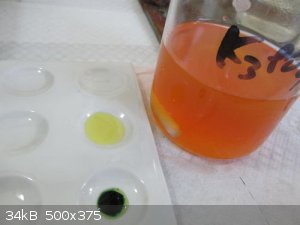
aga - 8-4-2018 at 12:42
Anyone got a clue as to what the Green stuff in 72% agricultural grade phosphoric acid might be ?
I did some reactions with it

... and got a pile of airport food

(reacted with K2CO3, then filtered)
then some orange stuff

(reacted the filtrate with KOH)
After a short time the orange schmoo filtered nicely, leaving the orange behind.
It isn't Iron, as a test with potassium hexacyanoferrate shows.
The top spot-plate cell is the stuff, bottom is some acid from an iron(II) sulphate sample.
aga - 8-4-2018 at 13:43
Anyone ?
Ah. Timezones and stuff.
A lot of people are busy or asleep.
Morgan - 8-4-2018 at 16:21
"This green colour is due to the presence of Fe2+ ions."
https://onlinelibrary.wiley.com/doi/abs/10.1002/jctb.2805503...
"Crude phosphoric acid made by reacting rock phosphate with sulphuric acid is greenish or brownish. At least part of the colour is due to iron."
https://www.thenakedscientists.com/forum/index.php?topic=418...
"For example, wet process phosphoric acid contains significant amounts of uranium which can be separated for recovery by solvent extraction."
https://patents.google.com/patent/US4256570
Boffis - 8-4-2018 at 21:30
am not sure that the Prussian blue test will work under these conditions for two reasons. 1) It doesn't work under basic conditions and you don't
know (or didn't tell us) how much potassium carbonate you used to neutralize the phosphoric acid so we can't be sure which salt type you actually have
in solution and 2) phosphate ions complex with Fe3+ under certain conditions and given that basic conditions undermine the stability of the Prussian
blue test anyway the phosphate ions will tend to further suppress the blue colour formation.
Remember (it has been discussed before on SM) alkali + Prussian blue = ferrocyanide solution and Fe oxide/hydroxide ppt
This was the original method of preparing sodium and potassium ferrocyanide from "blue billy" the waste from coal gas purification.
At the very least you need to buffer your solution to pH 5-7 before you mix the ferrocyanide solution but I am still not sure you will see the
Prussian blue reaction because of the high phosphate ion concentration. The only way I can think of to separate the iron from phosphate complexes is
with H2S, filter of the sulphides and dissolve in acid (+ H2O2 usually helps) and then buffer with sodium acetate and carry out the test. Salicylic
acid is then a good test too (deep purple colour)
aga - 8-4-2018 at 23:28
Thanks for the superb replies.
I'll go and test again, properly.
Edit:
Yep. The raw acid, diluted, instantly tests +ve for iron.
[Edited on 9-4-2018 by aga]
